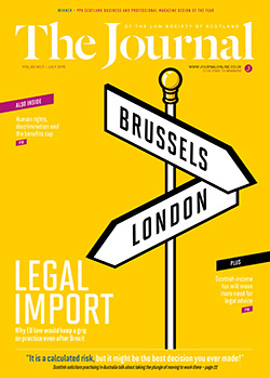Transforming perceptions

One of the most interesting things about the legal profession is its diversity, with all types of people caring passionately about the rule of law and justice.
Different generations have fought different battles in becoming solicitors. Women weren’t admitted to the profession until the 1920s, and in the 1940s a Jewish solicitor raised a case against the Society about the name he practised under. Compare that to now, when we have a 50:50 gender split, openly gay lawyers work in every field, and a recent intervention led by the Society ensured that Sikh solicitors could wear their kirpan in all aspects of professional life.
But how often do we talk about “trans” (transgender) solicitors and trans clients, i.e. those whose self-identity does not conform unambiguously to conventional notions of male or female, or alternatively to the gender they were assigned at birth?
It’s no longer a taboo subject. We watched Hayley on Coronation Street for years; Caitlyn Jenner (former Olympian Bruce Jenner and former husband of TV personality Kris Kardashian) graced the cover of Vanity Fair in June as her new self; and the BBC is launching its first mainstream family comedy with a trans lead, Boy Meets Girl. But after 10 years of equality research on the Scottish legal profession we realised we still don’t know much, and visibility of these colleagues is low.
We therefore decided to do more in-depth work following our 2013 Profile of the Profession research, which generated over 3,500 responses, and commissioned an independent researcher to carry out interviews.
I was initially concerned that of a number of trans people practising in the profession, only one individual, still on the route to qualification at the time, stepped forward. Was this a research failure? No. This moving case study of a remarkable and cheerful individual offers as much to learn from as the statistics in the three-yearly census.
I encourage everyone to read the case study, published on the Society’s website www.lawscot.org.uk/about-us/equality-and-diversity/the-society/published-research/. It offers real insight into someone any of us could have as a friend, colleague or family member.
The trans experience
As the Society’s staff lead on equality and diversity, I thought I was switched on to such issues, but it provided important reminders, including:
Gender identity is not binary – the person who transitioned from female to male still saw that identity as a concession. Male was more comfortable than female, but their natural personality was more androgynous and/or fluid. It’s worth being aware that Australia has just recognised, in law, a “third gender”.
Transphobic or homophobic comments are still heard too frequently – our interviewee recognised that in many work environments this is not the case, but reported an internship experience which involved constant use of inappropriate language. This should be unacceptable in the workplace, but it is still reported by huge numbers of our members in our equality research.
Traineeship interviews are hard – this candidate had a first class degree and excellent references. It is very clear they do not want to be part of a “chip on the shoulder” minority, but it raises doubt about fair treatment. The legal profession will continue to have to battle against perceptions, unfair or otherwise, if it does not actively welcome diversity and recognise its many benefits.
Lawyers should lead the debate about gendered language – lawyers are used to “he” in statute and regulations, and, as a result, its use in guidance and advice. However it’s not just that it might be old fashioned, it can be entirely inappropriate, particularly for those with more complex gender identity.
Words need actions
One specific comment that struck home was: “There’s such a gulf between a firm having a policy and actually doing anything with it.” Equality is much more than a bit of paper, although preparing a plan and measuring outputs and outcomes remain important.
Another was around lack of role models and feeling isolated: “It’s difficult never seeing yourself reflected anywhere. I never felt like there was any acknowledgment that there might be trans people in the profession.”
The interviewee recommended that the Society talk more about trans members and issues, normalising it over time as we have with other equalities groups. The research and article are a step forward; I hope both will be widely read so people know there are great role models already in our profession.
The issue also extends to client relationships, from evidence for eligibility and money laundering tests,
to knowing current thinking about “eldest son”, or “divided between my daughters” in wills, if someone
has changed gender.
A seminar we hosted two years ago for more than 60 lawyers highlighted that these issues are becoming more common. Increased knowledge and confidence in working with trans people can help prevent client issues arising and improve the service solicitors can offer.
For some, equality issues can seem remote or simply “political correctness”. However meeting someone who is dealing with these issues every day, transforms an “issue” into a person – and at that point most of us take a different view.
In this issue
- Caught by the cartels
- Refugees: why article 31 matters
- Virtual victims?
- How much should trainee solicitors be paid?
- Reading for pleasure
- Opinion: Malcolm Combe
- Book reviews
- Profile
- President's column
- Plans reports: yes or no?
- Farewell Brussels?
- Mind games
- Justifying discrimination
- Advance to Australia fair
- People on the move
- Reason for the rules
- Beware the (new) transfer traps
- Pension schemes: the VAT rules change
- Tenancies and the Land Reform Bill
- Scottish Solicitors Discipline Tribunal
- Are you ready for counterpart signing?
- Chapter and verse
- Street Law: a wildfire success
- Law reform roundup
- ADR directive affects complaints
- From the Brussels office
- Transforming perceptions
- Litigators in a fix?
- Unlucky Fridays?
- Flag up, or keep mum?
- Send in the auditors






